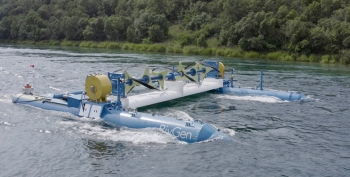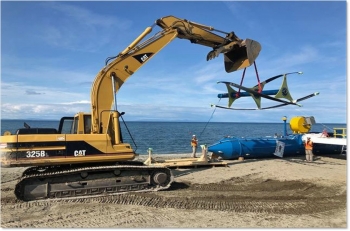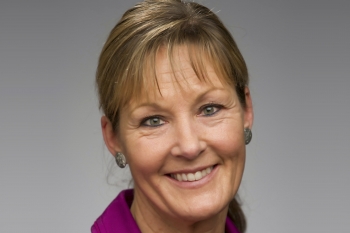Igiugig Proves RivGen Hydrokinetic Power System Can Produce Power, Survive Winter, Coexist with Salmon

The Native Village of Igiugig is one of 250 remote communities in Alaska that rely on isolated, diesel-powered microgrids.
Igiugig, or "the place where the river swallows the lake,” sits at the headwaters of the Kvichak River at the outlet of Lake Iliamna—a nursery for the largest red salmon run on Earth.
For nearly a year, the same current that has carried young salmon to their feeding ground in Bristol Bay “since time immemorial” has also proved it can produce power for the people of Igiugig—without interfering with the fish.
Igiugig’s resilient energy goal, set two decades ago, led to the installation of their Ocean Renewable Power Company (ORPC) RivGen hydrokinetic power (HKP) system in January. The pilot, which Igiugig Village Council President AlexAnna Salmon highlighted in a recent DOE Office of Indian Energy webinar, marks the first commercial deployment of this emerging technology. A second RivGen device will fast-track Igiugig’s goal.
With the integration of another HKP generator and a battery energy storage system into its microgrid next year, co-funded by DOE, Igiugig expects to meet its “diesels off” goal 4 years ahead of schedule.
“We are pretty proud that for 9,000 years, our people have lived in this same area in southwestern Alaska and lived sustainably,” Salmon said during the October 28 webinar “Tribal Microgrids: Exploring the Why and How.” But over the past 50 years, the community has become “extremely dependent on diesel,” leaving it highly vulnerable to fluctuating fuel prices.
Although Alaska’s Power Cost Equalization (PCE) program helps mitigate the disproportionate cost burden residents of remote, rural communities carry, the program itself is dependent on factors outside of Igiugig’s control.

Igiugig Embraces Renewables to Reduce Risk, Rev Up Resilience
"I always think about our resilience—which is dependent on diesel—as highly dependent on what happens at other levels of government," Salmon said. “We would like to insulate ourselves from that.”
Twenty years ago, that desire drove Village leaders to embark on a journey toward sustainability and self-determination, with the goal of going “diesels off” by 2025. Now, having proved the RivGen can weather the seasons and produce power without impacting the ecosystem, they are moving to install a second device and integrate HKP and a battery energy storage system into their local diesel-fueled power plant.
“We saw the writing on the wall,” Salmon said. “Our leadership met and said, ‘We want to … pursue alternative energy, not only because it will be best for our people, but because, environmentally and culturally, it aligns with our values to have a low carbon footprint.’”
Today, with diesel representing just under 60% of the energy mix, it still costs $250,000 a year to run the local power plant that supplies electricity to Igiugig’s 70 residents. Their cost per kilowatt-hour is almost 10 times what folks pay in the Lower 48. And there are other costs associated with being highly reliant on imported diesel, Salmon explained.
First, flying fuel in can be dangerous. “Our runway is not equipped for it. Our equipment for receiving it is aging. Our bulk fuel farm, which holds 114,000 gallons, is situated at the headwaters of the world’s last largest salmon run. These things all hit close to home.”
On top of the risks, keeping the lights on is costly. “We’re paying almost one dollar per kilowatt-hour [for electricity],” Salmon said. “And if programs like PCE were to go away, our residents would have a hard time affording to live in our community.”
Even if Igiugig’s energy transition does not reduce the cost of power, the Village sees value in creating local jobs, reducing their carbon footprint, and creating a sustainable community. Salmon views that mentality as foundational to the RivGen project. “Every time our Village has been faced with an opportunity or a challenge, we have asked ourselves, ‘What do we have to lose?’”
It’s a progressive perspective that is rooted in traditional values—education, respect for elders, self-determination, sustainability. Beyond the RivGen project, Igiugig boasts several forward-thinking programs, from its community greenhouse and local food initiative to its award-winning recycling program.
“We have always focused on … involving youth in our decision making,” said Salmon. “And the question has always been, ‘What kind of a place does Igiugig want to be for our children to want to remain?’”
Village Becomes a Living Laboratory for Marine Hydrokinetic Power
With risk-mitigation in mind, Village leaders set their sights on 2025 and began mapping out a path to their target. They explored and tested a range of options, including wind, solar, and hydropower, before settling on HKP—an emerging technology that harnesses the power of oceans and free-flowing rivers to generate clean, renewable, reliable energy.
“We have gone down several paths, but the most promising to date has been hydrokinetic power,” said Salmon. “The Kvichak River doesn’t freeze because of the power of the current. It’s 24/7/365, and it doesn’t fluctuate.”
Like traditional hydropower, HKP can provide the dispatchable baseload power electric grids need to ensure consistent, reliable generation. But unlike big hydro, which depends on dams, HKP relies on the river’s flow, rather than interfering with it.
For Igiugig, collaborating with Portland, Maine-based ORPC on an HKP demonstration project was a way to turn a challenge into an opportunity—one with tremendous potential to not only advance Igiugig’s energy goals but the broader transition to sustainable energy systems.
The RivGen’s core component is a turbine generating unit that works on the same principle as the paddle wheel, using the force of moving water to turn turbine foils and power an underwater generator. ORPC wanted to prove the viability of its technology in a remote community, demonstrating it could withstand the seasons, generate electricity, and tie in to the village power grid.
Igiugig also needed to ensure that the RivGen could handle the harsh environmental conditions—and, more importantly, that it would not impact the salmon.
“We became a literal plug-and-play community,” said Salmon, recalling her “a-ha” moment during a visit to the energy laboratory (lab) in Fairbanks. “They have this entire lab, and they’re inputting all of these renewable energy options and running this generator to simulate a village. And I thought, ‘Why can’t we bring those resources to a real village and simulate it in real life?’”
The Village and ORPC deployed the first RivGen hydrokinetic generation system in January 2020. Having now operated for more than 10 months, it has the distinction of being the longest-operating current energy converter in the country.

It Takes a Village
Meeting this milestone has required patience, perseverance, and teamwork.
All of the RivGen components were trucked and shipped from Maine to Homer, brought by barge to Williamsport, and hauled over a 13-mile mountain pass portage road to the east end of Iliamna Lake and loaded onto a barge for the final, 90-mile leg of their journey to Igiugig.
“If it can happen in Igiugig, it could happen anywhere in the world,” said Salmon. “Because it’s so geographically challenging to get here.”
Everything must be trucked and barged in and then assembled by local crews using local equipment, explained Karl Hill, Vice President of the Igiugig Village Council, who owns the construction company that offloaded the barge, assembled the equipment, and lowered the device to the riverbed.
The next phase of the multiyear project consists of tying the RivGen and the battery energy storage system into Igiugig’s diesel-generated microgrid, transforming it into a smart grid.
“It’s complex integrating these devices. Like many of the 250 microgrid villages in Alaska, we’re challenged to just maintain and run our local power plant with its 65-kilowatt [diesel] generators,” said Hill.
Growing local capacity to not only assemble and tie multiple technologies into their microgrid but also maintain and operate it is a top priority, he explained. “Our commercial fishermen are our boat drivers and equipment operators, and it’s very important that we have the capacity to run this system day to day. Solid teamwork has been key. We’re all learning as we go.”
Salmon underscored the importance of teamwork. “Everyone has tried to the best of their ability to honor the wishes of the community not to be singularly focused on one type of resource. So the hydro people are talking to the wind people, and together they’re looking at an integrated approach [and] bringing us to the point where, a year from now, we’ll really need to sit down as a community and … think about the risks and benefits of owning this alternative energy. What we’re navigating is very unique in Alaska.”
“We’re Just a Water People”
Salmon is confident in Igiugig’s ability to realize the resilient future the Village seeks by relying on the resources that have propelled them for centuries.
“Our river has supplied all of our salmon and food for centuries. It’s our only drinking water, and it has a lot of power. We’re just a water people…. Since time immemorial, our people have survived inventing or adapting to new technologies, then refining them to the highest efficiency. We perpetuate this way of life.”
Watch a video on Igiugig’s resilient microgrid project, and listen to a podcast conversation between Salmon, Stuart Davies of OPRC, and Senator Lisa Murkowski, Chairman of the U.S. Senate Energy & Natural Resources Committee.

